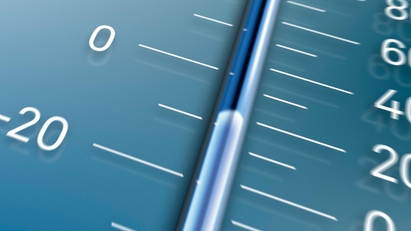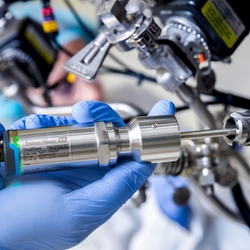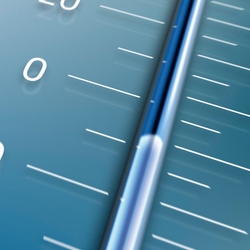Temperaturmåling
Termometre og transmittere til procesindustrien
Har du brug for hjælp til at vælge og dimensionere din næste enhed?
Vælg, dimensioner og konfigurer nemt de bedst egnede produkter til dine måleopgaver og applikationer.
Instrumenter til temperaturmåling
Endress+Hauser tilbyder et komplet sortiment af kompakte temperaturfølere, modulære termofølere, termorør, måleindsatser, transmittere og tilbehør til alle typer procesindustrier som f.eks. olie og gas, kemikalier, fødevarer, life sciences, primærindustrien og metal, strøm og energi.
Termometre og temperaturtransmittere
Vores omfattende portefølje tilbyder globalt tilgængelige, standardiserede termometre til måling af temperatur i industrielle og hygiejniske applikationer på tværs af alle procesindustrier. Vi forbedrer anlæggenes tilgængelighed, effektivitet og sikkerhed gennem enestående kundecentrerede innovationer. Vores internationalt testede og certificerede produkter sikrer problemfri integration, brugervenlighed og langsigtet pålidelig ydeevne.
I kombination med Endress+Hauser-transmittere passer vores temperatursamlinger perfekt til alle brancher og en lang række applikationer. Forskellige typer huse, forskellige digitale og analoge udgangssignaler, godkendelser og meget mere sikrer et optimalt udvalg og gør termometrene velegnede til en lang række styresystemer.
Anlægssikkerhed og problemfri anlægscertificering: Internationale godkendelser til metrologi, kritiske områder, sikkerhed og meget mere Problemfri systemintegration: Alle almindelige protokoller - fra analoge til digitale udgange
Læs mere om temperatursensorer og måleprincipper
Hvad er et termometer, og hvad er det særlige ved termometre, der bruges i procesautomatisering?
Et termometer er et instrument, der måler temperaturen. Temperaturmåling er et grundlæggende aspekt af videnskaben og dagligdagen, lige fra madlavning til vejrudsigter. Det er den hyppigst målte parameter i procesindustrien og yderst relevant for processikkerhed, effektivitet og kvaliteten af de endelige produkter.
Temperatursensorer og deres måledata er den afgørende faktor i et stort antal industrielle processer, og derfor skal enhederne være pålidelige og nøjagtige. Standardinstrumenter til måling af temperatur i vores hverdag kan af flere grunde ikke sammenlignes med industrielle temperatursensorer .
Infrarøde termometre måler temperaturen på afstand ved at registrere den infrarøde stråling, der udsendes af genstande. Faktorer som materiale- og overfladeegenskaber påvirker emissiviteten og dermed nøjagtigheden af denne måling. Det kan give unøjagtigheder under barske og skiftende forhold. I industrielle processer er den variabel, der skal måles, desuden typisk temperaturen på mediet i et rør eller en beholder og ikke overfladetemperaturen, som registreres af den infrarøde måling.Husholdningstermometre indeholder ofte en væske i et smalt glasrør, som udvider sig, når det opvarmes, og dermed indikerer temperaturændringer. Kviksølv er et af de mest kendte materialer, der bruges i væsketermometre. De skrøbelige materialer og den høje forureningsrisiko gør dem uegnede til barske og ofte højtryksindustrielle miljøer.Elektroniske termometre med digitale displays bruges i vid udstrækning i bærbare enheder eller til måling af rumtemperatur. De kan overvåge kropstemperatur og omgivelsestemperatur og levere data til sundhedsovervågning og miljøbevidsthed. De er omkostningseffektive og kompakte, men opfylder ikke kravene til industriel brug med hensyn til nøjagtighed, robusthed og langtidsstabilitet.Af disse grunde foretrækkes RTD (Resistance Temperature Detector) eller termoelementsensorer i industrielle processer. De er designet til præcist og pålideligt at måle temperaturen i rør eller tanke under barske procesforhold.
Hvad er de forskellige enheder for temperaturmåling?
De tre mest almindelige enheder til temperaturovervågning er Celsius, Fahrenheit og Kelvin. Celsius-skalaen er en del af det metriske system, mens Fahrenheit er en del af det imperiale system. For at konvertere Celsius til Fahrenheit skal du gange Celsius-temperaturen med 1,8 og derefter lægge 32 til. Et eksempel: Vands kogepunkt er 100 grader Celsius og 212 grader Fahrenheit. Kelvin-skalaen bruger ikke grader; den bruger kelvin (K) som måleenhed. Celsius- og Fahrenheit-skalaen bruges mest til temperaturmåling, mens Kelvin-skalaen ofte bruges til videnskabelig forskning eller til at angive temperaturforskelle.
Hvilke typer procesinstrumenter til temperaturmåling findes der?
Invasiv (direkte kontakt)
I rør eller beholdere kan man normalt opnå den hurtigste og mest nøjagtige måling med et direkte nedsænkningstermometer uden beskyttelsesrør. Dette er dog ikke muligt i mange applikationer og har forskellige ulemper. For eksempel skal processen lukkes ned for at fjerne eller udskifte termometeret, og røret skal muligvis tømmes. Desuden medfører direkte installation risiko for forurening og hurtig slitage, især hvis termometeret udsættes for barske procesforhold som f.eks. ætsende eller slibende medier.
Invasive (with thermowell)
En invasiv måling med en termolomme giver mulighed for at udskifte temperatursensoren uden at afbryde processen. Hvis beskyttelsesrørets materiale og geometri er valgt, så det passer til processen, kan termometret desuden have en meget lang levetid. Termolommer forstyrrer dog procesflowet, fører til tryktab i rørledningen og er også udsat for slitage, hvilket kan kræve regelmæssig vedligeholdelse og om nødvendigt udskiftning af beskyttelsesrør, især i kritiske applikationer. Brugen af beskyttelsesrør reducerer typisk et termometers responstid sammenlignet med termometre med direkte kontakt.
Ikke-invasiv (overflademåling)
Der er udviklet nye termometriske teknikker, som gør det muligt at overvåge procestemperaturen uden at indsætte en sensor i procesmediet. Disse ikke-invasive temperatursensorer monteres på overfladen af røret eller beholderen. Intelligent design og avancerede teknologier sikrer optimal varmestrøm til sensorelementet, hvilket minimerer målefejl og -usikkerhed. Da disse temperatursensorer ikke trænger ind i rørvæggen, kan typiske problemer som lækage, slitage eller negative effekter på processen undgås. Ikke-invasive termometre er nemme at installere, kan eftermonteres og er næsten vedligeholdelsesfrie. Eksterne faktorer som omgivelsestemperatur og overfladeforhold kan dog påvirke målenøjagtigheden. Derfor anbefales varmeisolering af målepunktet til de fleste applikationer.
Hvad er komponenterne i en temperaturenhed?
The insert is located in the thermowell , with the thermowell being the process wetted component of the assembly. It increases the lifetime of the measurement insert by protecting it against harsh process conditions (corrosion, abrasion, process pressure etc.) and allows to exchange the measurement insert without process interruption.
The tip of the measurement insert contains the temperature sensor element , the most important component, as it provides precise and reliable measurement data through an electrical signal.
In order to transmit the raw signal towards the process control system, it is necessary to convert it into a standardized analog or digital signal. This conversion is the task of the transmitter - it acts as a smart interface between the sensor and the PLC. It offers enhanced accuracy and signal stability, reduced wiring costs and advanced diagnostic functions.
The transmitter is placed in the terminal head, which is fitted to the thermowell or the neck of the thermometer. It protects the transmitter and acts as a junction box for wiring all different components. Some terminal heads also provide a local display for indication of measurement values and status information.
Other components are the process connection , the connection between the process and the thermometer, and the extension neck , the connection between the terminal head and process connection/thermowell. The neck protects the head transmitter from overheating by creating a distance to the often hot process temperatures. It also guarantees access to the terminal head in the case of pipe insulation.
What are the most common types of temperature sensors used in industrial applications? What’s the difference between thermocouples and resistance temperature detectors?
Both RTD and TC are widely used in industrial applications to measure temperature. Choosing between thermocouple and resistance temperature detector depends on the specific requirements of the application including temperature range, accuracy, environmental conditions, and budget.
RTDs excel in accuracy, linear response, long-term stability, and resistance to electrical noise, making them ideal for precisely and reliably measuring temperature in controlled environments.
Thermocouples are advantageous for their wide temperature range, durability, fast response time, and cost-effectiveness, making them suitable for extreme industrial conditions and high-temperature applications.
Most methods for monitoring temperature rely on physical properties of materials that vary with temperature. Temperature can be measured by examining changes in physical properties e.g. electrical resistance or voltage. Industrial temperature sensors typically use two types of measurement principles:
1. Resistance Temperature Detector (RTD)
Negative Temperature Coefficient (NTC): These sensors exhibit higher resistance at low temperatures and lower resistance at higher temperatures. / Positive Temperature Coefficient (PTC): These sensors exhibit lower resistance at low temperatures and higher resistance at higher temperatures.
In industrial processes, resistance temperature sensors are most common. An RTD is typically made of high-purity metals. The temperature sensor typically consists of a length of wire made from pure metals such as platinum, nickel, or copper. The electrical resistance of the sensor metal increases as the temperature rises. This change in resistance is measured and converted into temperature readings. Resistance thermometers in industrial processes typically use a platinum sensor, either a Pt100 or Pt1000 temperature sensor. These sensors are standardized e.g. according to IEC 60751. The Pt100 temperature sensor is a temperature-sensitive platinum resistor with a resistance of 100 Ω at 0 °C (32 °F) and a temperature coefficient α = 0.003851 °C-1
2. Thermocouples (TC)
Thermocouples are comparatively simple, robust temperature sensors which use the Seebeck effect for temperature measurement. If two electrical conductors made of different materials are connected at a point, a weak electrical voltage can be measured between the two open conductor ends if the conductors are subjected to a thermal gradient. This voltage is called thermoelectric voltage or electromotive force (emf). Its magnitude depends on the type of conducting materials and the temperature difference between the "measuring point" (the junction of the two conductors) and the "cold junction" (the open conductor ends). Accordingly, thermocouples primarily only measure differences in temperature. The absolute temperature at the measuring point can be determined from these if the associated temperature at the cold junction is known or is measured separately and compensated for. The material combinations and associated thermoelectric voltage/temperature characteristics of the most common types of thermocouple are standardized in the IEC 60584 and ASTM E230/ANSI MC96.1 standards.
What are the different types of resistance temperature detectors?
Thin-film platinum resistance thermometers (TF): A very thin, ultrapure platinum layer, approx. 1 μm thick, is vaporized in a vacuum on a ceramic substrate and then structured photolithographically. The platinum conductor paths formed in this way create the measuring resistance. Additional covering and passivation layers are applied and reliably protect the thin platinum layer from contamination and oxidation, even at high temperatures. The primary advantages of thin-film temperature sensors over wire-wound versions are their smaller sizes and better vibration resistance. A relatively low principle-based deviation of the resistance/temperature characteristic from the standard characteristic of IEC 60751 can frequently be observed among TF sensors at high temperatures. As a result, the tight limit values of tolerance class A as per IEC 60751 can only be observed with TF sensors at temperatures up to approx. 300 °C (572 °F).Wire-wound (WW): In these thermometers, a double coil of fine, high-purity platinum wire is accommodated in a ceramic support. This support is then sealed top and bottom with a ceramic protective layer. Such resistance thermometers not only facilitate very repeatable measurements but also offer good long-term stability of the resistance/temperature characteristic within temperature ranges up to 600 °C (1112 °F). This type of sensor is relatively large in size and comparatively sensitive to vibrations.
Why should I use a temperature transmitter instead of direct wiring?
Using a transmitter offers several advantages over direct wiring. While direct wiring simply transmits the raw sensor signal, a transmitter enables communication through various analog and digital protocols such as Profinet (via Ethernet-APL) or IO-Link. This allows seamless integration into the plant’s digital communication infrastructure. Bluetooth-enabled transmitters even allow for particularly easy configuration and remote control.
Transmitters provide more than just the measured value. They can deliver additional diagnostic and status information, enhancing process reliability. Furthermore, transmitters can "smartify" the thermometer or measurement point, turning them into intelligent nodes within the system. This not only improves data quality and accessibility but also supports predictive maintenance and efficient process control.
Which factors can affect the accuracy of temperature measurements in industrial environments? How can the accuracy of an industrial thermometer be increased?
The accuracy of temperature sensors depends on several factors:
Sensor accuracy: temperature sensors have standardized accuracy classes according e.g. IEC60751 or IEC60584. Platinum RTDs (resistance temperature detector) typically offer more accurate temperature measurement compared to TCs (thermocouples). Temperature transmitter accuracy: the performance characteristics of the transmitter have a direct influence on the overall accuracy of the thermometer. Installation conditions and thermometer design: correct and smart design of the measurement point and temperature sensor has the biggest influence on overall measurement performance and accuracy. Properties like immersion length, thermal masses, thermal conduction and coupling, thermal insulation from ambient conditions, material properties and more are to be considered and wisely orchestrated. Suitable design and technology is vital for achieving best possible measurement performance. If not done correctly, even the most sophisticated sensor or transmitter technology cannot achieve good results. Often too little attention is paid to installation conditions and thermometer design. Endress+Hauser can help you to design your measurement point optimally.
Sensor-transmitter-matching by Endress+Hauser offers additional reduction of the thermometer measurement uncertainty. It ensures the highest accuracy when ordering a thermometer including a transmitter. With an in-house calibration, the individual sensor characteristic curve is determined and stored in the transmitter via the Callendar-Van Dusen coefficients . In this way, sensor and transmitter are optimally tuned and measurement deviations are reduced to a minimum.
What is a calibration and how often should industrial temperature sensors be calibrated?
A calibration is the process of verifying the accuracy of the measurement device (thermometer) by comparing its readings to a known standard or reference. This ensures that the device accurately and reliably measures temperature within defined tolerances.
Temperature is a crucial parameter for many processes determining product and plant safety as well as process efficiency. To ensure long-term stability and safety, regular calibration (recalibration) is necessary. The frequency of recalibration intervalls should be determined depending on the temperature sensor type, the process conditons, the criticality of the temperature measurement point and imposed risks arising from deviations. The frequency of recalibration is usually determined by balancing effort and risk based on experience and knowledge.
A clever and unique option is the Endress+Hauser self-calibrating compact thermometer iTHERM TrustSens. It reduces risks and costs by a fully automated, traceable inline self-calibration. The hygienic thermometer makes use of the Curie effect, having a built-in, long-term stable fix point reference with complete traceability of the calibration chain according to ITS-90.
How do I choose the right temperature sensor for my industrial process?
Consider your application and process data to make the right choice. Most important factors are process temperature range , required measurement performance such as accuracy & response time , installation and environmental conditions . The selection and configuraton of each thermometer (e.g. invasive vs. non-invasive, direct contact vs. thermowell, resistance temperature detector vs. thermocouple, transmitter model and communication protocol, necessary approvals such as hazardous areas or SIL requirements, type of process connection and all other components) depends on these factors.
Endress+Hauser offers a complete and highly flexible range of thermometers for measuring temperature, as well as components that ensure the best possible measurement solution for any industrial application in process automation.
Industrial thermometers: Hygienic thermometers: Compact thermometers Multipoint thermometers High temperature sensors include innovative thermowell materials such as non-porous ceramics with improved wear and chemical resistance. The thermocouple sensors can measure temperature in applications up to +1700 °C (+3092 °F) in furnaces or melts e.g. in the metal industry, waste incinerators, cement production or glass industry. Surface or non-invasive temperature sensors are used to measure the process or pipe temperature by only touching the outer surface of the pipe (or vessel). They reduce the risk of leakage and prevent flow problems in small pipes, in pipes that require pigging, and in highly corrosive or abrasive applications. Cable probe temperature sensors Using the Endress+Hauser product configurator helps you create a thermometer to measure temperature in your process, deciding on the version of every single component. All components to measure temperature such as thermowell, transmitter, terminal head, process connection, neck/lagging, measurement insert, temperature sensors and further accessories are available from Endress+Hauser.
Show more
Show less
Ved at skifte til den nye type temperaturføler TM411, har Christian Hansen opnået en forbedring af temperaturovervågningen.
iTHERM TrustSens - Verdens første selv-kalibrerende temperaturføler!
Endress+Hauser tilbyder et komplet sortiment af kompakte temperaturfølere, modulære termofølere, termorør, måleindsatser, transmittere og tilbehør til temperaturmåling til alle typer procesindustrier.
Downloads
Udforsk yderligere indhold
Temperaturmåling for procesindustrien
Temperaturmåling – termometre og sendere til procesindustrien
Download
Vi værner om dine personlige oplysninger
Vi anvender cookies for at forbedre din browseroplevelse, indsamle statistiske oplysninger med henblik på optimering af webstedets funktionalitet og levere skræddersyede annoncer eller indholdselementer.
Hvis du vælger "Accepter alle", giver du dit samtykke til vores brug af cookies.Cookiepolitik .
Tilpas
Accepter kun essentielle
Accepter alle


%20ny.jpg)

